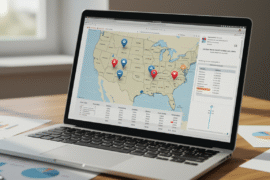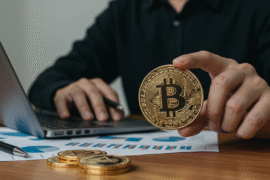This article may contain references to products or services from one or more of our advertisers or partners. We may receive compensation when you click on links to those products or services. Nonetheless, our opinions are our own.
The information presented in this article is accurate to the best of our knowledge at the time of publication. However, information is subject to change, and no guarantees are made about the continued accuracy or completeness of this content after its publication date.
Key Highlights
- Purchasing power is how much you can buy with one unit of currency.
- Inflation reduces purchasing power, meaning your money can buy less over time.
- The Consumer Price Index (CPI) is vital to measure inflation.
- Having a variety of investments can lessen the effects of inflation.
- Understanding purchasing power is essential for making wise financial choices.
Introduction
Have you ever noticed that your favorite snack costs more while the bag has less? This is a sign of inflation and how it affects purchasing power. Purchasing power is how much you can get with your money. When inflation rises, the Consumer Price Index (CPI) shows a higher level. This means your purchasing power decreases. In simple terms, your money buys fewer goods than before. Understanding this change is essential when planning your spending.
Understanding Purchasing Power
Purchasing power is a key concept in economics that impacts our everyday lives. It tells us how much our money can actually buy, and this value influences how we spend, save, and invest. For example, with $100 today, you can purchase items like gallons of milk, bread, or movie tickets.
Over time, what you can get for $100 can change significantly. The number of things you can buy may increase or decrease in a year or even ten years. Understanding these changes is essential to grasp purchasing power.
Defining Purchasing Power in Simple Terms
Purchasing power refers to what you can buy with one unit of currency. For example, the dollar’s purchasing power shows what one dollar can buy in the United States. This power can fluctuate over time based on the economy.
When a currency has high purchasing power, people can buy more with their money. However, when prices increase due to inflation, the purchasing power of that currency decreases—conversely, the purchasing power increases if prices decline, known as deflation. Several factors affect purchasing power, including inflation rates, wages, and government policies. Understanding these factors helps in making better financial decisions.
The Role of Inflation in Purchasing Power
Inflation occurs when prices for goods and services increase over time. As this occurs, money loses its value, meaning each dollar buys fewer goods and services, resulting in a decrease in purchasing power.
To measure inflation in the U.S., the Bureau of Labor Statistics (BLS) tracks the prices of a group of goods and services and calculates the Consumer Price Index (CPI). This index reflects how much prices change for city consumers when they buy everyday items.
When the CPI goes up, inflation occurs. This is important because you will need more dollars to buy the same things as before. As prices increase, purchasing power decreases, affecting what you can afford.
Voted "Best Overall Budgeting App" by Forbes and WSJ
Monarch Money helps you budget, track spending, set goals, and plan your financial future—all in one app.
Get 50% OFF your first year with code MONARCHVIP
The Impact of Inflation on Your Money
Inflation slowly decreases the value of your savings over time. When prices rise, the amount of goods you can buy with your money decreases. This is especially concerning for people on fixed incomes, as it becomes harder to afford necessities.
If you saved $100 a year ago, you may find it does not buy the same basket of goods today. Even though the money remains the same, its purchasing power has declined due to inflation.
How Inflation Erodes Purchasing Power Over Time
Imagine saving $100 in a piggy bank today. With that, you can buy 10 gallons of gas. When you take out the money to buy gas a few years later, you realize prices have risen, and your $100 now buys only five gallons. This drop in what your money can buy is caused by inflation.
The price index shows how the cost of a basket of goods changes over time. When the price index rises, the cost of goods and services increases. So, even if you still have $100, its value has decreased due to inflation. Managing your finances wisely can help you maintain your purchasing power over time.
Real-Life Examples of Inflation Impacting Purchasing Power
- Rising Grocery Bills: Grocery costs continue to increase, increasing living costs. This means the same basket of goods you used to buy now takes up more of your income.
- Housing Costs: Rent and home prices have significantly increased, making it harder for many people to maintain their standard of living.
- Transportation Expenses: Gas and public transportation prices have risen, tightening family budgets and impacting travel choices.
These examples highlight how inflation affects different aspects of daily life and emphasize the importance of financial planning.
Beginner’s Guide to Protecting Your Purchasing Power
Managing finances wisely is crucial for safeguarding money from the effects of inflation. This includes making strategic decisions about saving, investing, and spending to ensure money holds its value over time.
A key first step is to monitor inflation trends. Understanding these trends helps individuals plan their financial goals effectively. By watching economic indicators and adjusting financial plans when needed, you can protect your purchasing power and secure your financial future.
Essential Resources for Monitoring Inflation and Purchasing Power
- The Federal Reserve: The central bank of the United States works to keep prices stable. Their website provides valuable data and analysis on inflation trends and economic conditions.
- The Bureau of Labor Statistics (BLS) provides inflation and Consumer Price Index (CPI) data. Its reports help consumers understand how the cost of goods and services is changing.
By regularly reviewing these sources, individuals can make informed financial decisions and safeguard their purchasing power.
Step 1: Identify Inflation Trends
The Consumer Price Index (CPI) tracks how prices change over time for a basket of goods and services that people commonly buy. A higher CPI indicates rising prices, which impact spending and financial planning.
Example of CPI Data:
| Year | Consumer Price Index | Rate of Inflation |
|---|---|---|
| 2020 | 258.811 | 1.2% |
| 2021 | 263.150 | 4.7% |
| 2022 | 276.238 | 9.1% |
Understanding these changes helps individuals prepare for economic shifts and make better financial choices.
Step 2: Adjust Your Savings and Investment Strategies
Once you understand inflation, the next step is to adjust your savings and investment plans. Reviewing interest rates on savings accounts, money market accounts, and certificates of deposit (CDs) is essential.
The real interest rate is found by subtracting the inflation rate from the nominal rate. If your savings account has a 1% interest rate but inflation is 2%, your purchasing power is declining. Diversifying investments into stocks, real estate, or inflation-protected securities can help mitigate inflation’s impact.
Strategies to Mitigate Inflation’s Impact
Investing in Inflation-Protected Securities: Inflation-protected securities (IPS) are designed to safeguard investments from inflation. Treasury Inflation-Protected Securities (TIPS) are U.S. government-backed securities that adjust based on CPI changes.
Diversifying Your Investment Portfolio: Spreading investments across different asset types, such as stocks, bonds, real estate, and commodities, reduces the risk of inflation eroding financial stability. This strategy can help maintain purchasing power over time.
Conclusion
Understanding purchasing power during inflation is essential for managing finances wisely. Inflation lowers the value of money, making it crucial to monitor trends and adjust savings and investment plans. Diversifying investments and considering inflation-protected securities can help maintain financial security. Staying informed and proactive ensures financial stability despite economic changes.
Frequently Asked Questions
What is purchasing power?
Purchasing power refers to how much you can buy with a currency unit. If inflation increases, your purchasing power decreases, meaning your money buys fewer goods and services.
How does inflation impact purchasing power?
As inflation rises, the cost of goods and services increases, reducing the amount you can buy with your money.
What strategies help protect purchasing power during inflation?
Investing in inflation-protected securities, diversifying assets, and choosing high-yield savings options can help maintain purchasing power over time.

Reviewed and edited by Albert Fang.
See a typo or want to suggest an edit/revision to the content? Use the contact us form to provide feedback.
At FangWallet, we value editorial integrity and open collaboration in curating quality content for readers to enjoy. Much appreciated for the assist.
Did you like our article and find it insightful? We encourage sharing the article link with family and friends to benefit as well - better yet, sharing on social media. Thank you for the support! 🍉
Article Title: Purchasing Power Meaning: How Inflation Impacts Your Money
https://fangwallet.com/2025/03/15/purchasing-power-meaning/The FangWallet Promise
FangWallet is an editorially independent resource - founded on breaking down challenging financial concepts for anyone to understand since 2014. While we adhere to editorial integrity, note that this post may contain references to products from our partners.
The FangWallet promise is always to have your best interest in mind and be transparent and honest about the financial picture.
Become an Insider

Subscribe to get a free daily budget planner printable to help get your money on track!
Make passive money the right way. No spam.
Editorial Disclaimer: The editorial content on this page is not provided by any of the companies mentioned. The opinions expressed here are the author's alone.
The content of this website is for informational purposes only and does not represent investment advice, or an offer or solicitation to buy or sell any security, investment, or product. Investors are encouraged to do their own due diligence, and, if necessary, consult professional advising before making any investment decisions. Investing involves a high degree of risk, and financial losses may occur including the potential loss of principal.
Source Citation References:
+ Inspo
There are no additional citations or references to note for this article at this time.











































